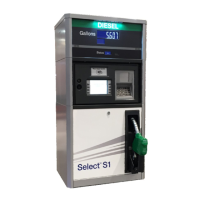W2940305 Rev 07 8/2019 Dover Fueling Solutions 11
2 Site Design & Preparation
2.1 Local, State, and Federal Codes
Select S1 Compact Electronic dispensers are only part of a fuel dispensing system. A fuel
dispensing system typically comprises equipment and safety devices from a variety of
manufacturers. It is the responsibility of the dispenser owner to have a qualified installer
ensure that all of the necessary equipment and accessories are included to meet the
requirements of the application and all tanks (both underground and aboveground), piping
and fittings, check valves, leak detection and corrosion protection devices, wiring, venting
systems, filtration devices, safety valves, submersible pumps, etc. are installed in accordance
with the manufacturer’s instructions and in compliance with local and regional building codes
and requirements pertaining to private fueling facilities (or other locations where the
dispenser may be installed).
These requirements may include references to the National Electrical Code (NFPA 70); Code
for Motor Fuel Dispensing Facilities and Repair Garages (NFPA 30A); Flammable and
Combustible Liquids Code (NFPA 30); Code of Federal Regulations, Title 40, Section 280 (40
CFR 280); United States Environmental Protection Agency (U.S. EPA) Technical Regulations
of 9-23-88 and U.S. EPA Financial Responsibility Regulations of 10-26-1988.
Where local requirements do not specify applicable codes, Wayne recommends using the
codes listed above. These codes are comprehensive and detailed, often requiring
interpretation to cover unusual situations, and, therefore, the associated handbooks (where
applicable) should also be consulted. (The handbooks are also available from the same
sources.)
Due to the variety of locations encountered, further information on installation cannot
be dealt with in this document except as the codes relate directly to the installation of
the dispenser. Therefore, it is strongly recommended that a qualified engineer or
contractor familiar with local regulations and practices be consulted before starting
installation.
Pertinent information and codes are available from the following sources:
Association for Composite Tanks (ACT)
North State Street
Suite 720
Chicago, IL 60602
(301) 355-1307 (for information requests)
American Petroleum Institute (API)
1220 L Street, N.W.
Washington, DC 20005
(202) 682-8000
Fiberglass Petroleum Tank and Pipe Institute
One SeaGate, Suite 1001
Toledo, OH 43604
(419) 247-5412
National Assoc. Corrosion Engineers
(NACE)
Box 218340
Houston, TX 77218
(713) 492-0535
National Fire Protection Association (NFPA)
One Batterymarch Park
Quincy, MA 02269-9101
(617) 770-3000
National Leak Prevention Association
(NLPA)
685 Fields Ertel Road
Cincinnati, OH 45241
(513) 489-9844 or 1-(800) 543-1838
Petroleum Equipment Institute (PEI)
Box 2380
Tulsa, OK 74101
(918) 494-9696
Steel Tank Institute
P. O. Box 4020
Northbrook, IL 60065
(312) 498-1980
(continued on next page)

